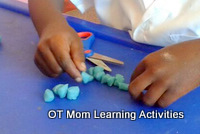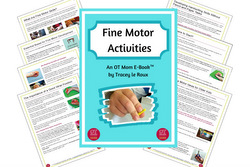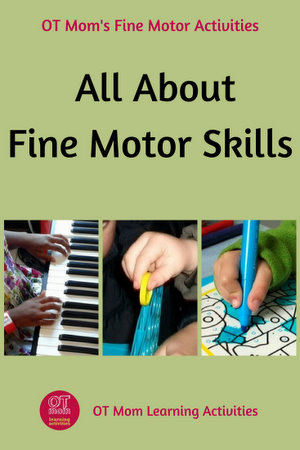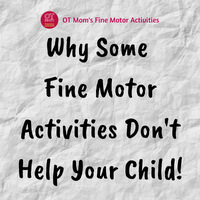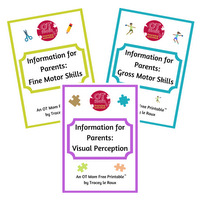- Home Page
- About Fine Motor Skills
What Are Fine Motor Skills?
As parents, we often hear health professionals and teachers talk about “fine motor skills”, but what does this term really mean? Although wiggling your toes and jiggling your eyebrows could be considered fine (small) muscle movements; when a teacher or therapist is talking about your child’s fine motor skills, they are usually referring to whether your child can use the hand and finger muscles effectively during age-appropriate tasks.
I sometimes link to products (#Ad) that are similar to those I use and love. If you do purchase something through my links, I will receive a small commission that helps support my site - thank you!
These are different to gross motor skills. Gross motor skills are the skills that involve the larger groups of muscles in the arms, legs and torso, which enable your child to walk, run, catch a ball and maintain a good sitting posture.
Here is what you need to know about these vital childhood skills:
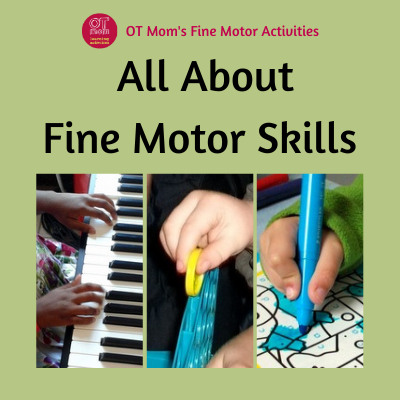
Why Are Fine Motor Skills So Important?
By the time children start formal schooling they need to be able to color with crayons, cut with scissors, paint with a paintbrush and play with small objects such as Lego, beads and puzzles.(Ref 1) Children need to use the hand and finger muscles effectively in order to keep up with peers in these activities.
Self-care activities such as doing buttons, pulling up a zipper, tying shoelaces and using a knife and fork to eat food, all require a degree of fine motor control.
As your child matures, there are many childhood activities such as playing a musical instrument, building with Lego and doing crafts such as beading, carpentry and model building, that require proficiency in fine motor skills.
Children who have difficulty with fine motor activities often feel frustrated and their self-esteem suffers when they can’t keep up with their peers. In addition, if your child struggles to control a pencil, this can affect handwriting, which means their written work might not reflect their potential.
So it is really important to give our kids the best possible start in fine motor development to help them achieve their full potential at school and at home.
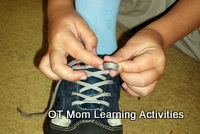 You need fine motor skills to tie your shoelaces!
You need fine motor skills to tie your shoelaces!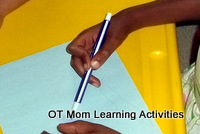 Poor pencil control can affect handwriting
Poor pencil control can affect handwritingWhat Can Cause A Fine Motor Delay?
If your child is having trouble with fine motor skills, it is natural to be wondering why. It is important to understand that these skills develop as part of your child’s overall growth. As with all areas of child development, a lag or delay in one area can impact on other areas of development.
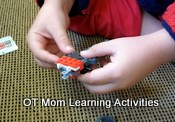
- If your child has experienced birth trauma, serious illnesses, physical deprivation or emotional trauma, he or she may be at risk for a delay in fine motor skills as well as delays in other skills.
- Poor core stability, weak shoulder girdle muscles, weak hand muscles, and poor coordination skills can all impact on your child's ability to use the hands and fingers effectively.
- Through no fault of their own, kids are sometimes not given enough opportunity to develop their fine motor skills because of their personal circumstances.
- We all face the challenge of balancing screen time with hands-on activities! Because kids are relying more on devices for learning and relaxation, they tend to engage in fewer hands-on activities, which can have an impact on fine motor development as well as other skills.
If your child is having trouble with fine motor skills, please speak to your health professional to get a professional assessment and opinion.
- Feeling alone and stressed about the challenges your child faces? Check out these Answers to Questions Parents Have Asked About Poor Fine Motor Skills!
- Find out what fine motor milestones apply for school-age kids in my article on fine motor development.
Tips To Improve Fine Motor Skills
Sometimes it is tricky to get our kids to put the devices down and use their hands and fingers more. The good news is that there are lots of simple activities you can do at home to help improve fine motor skills!
I have found that one of the best motivators for a child is quality time with someone who cares about them – so if you can get your child to join you in an activity, or come alongside them in a task, half the battle will be won. Even grandparents, an older sibling or a favorite auntie can be roped in to help get those fingers moving.
Here are some suggestions to help you incorporate fine motor activities into your everyday life at home:
Kitchen Fine Motor Activities:
- As a mom, I know it can be messy and time consuming, but if your child can peel a carrot or two, wash some dishes, knead some bread/cookie dough, their hands will thank you!
- What about having your child transfer some chopped salad ingredients from the board to the bowl with a pair of tongs? It is really worth seeing what small kitchen tasks you can outsource to your child each day.
- For some more inspiration check out my tips on baking with kids (with photos of my own kids in action)!
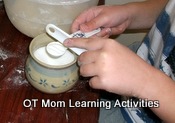 Measuring ingredients
Measuring ingredientsRemember, the goal isn't perfection - it's about building confidence and skills while spending quality time together.
Bath Time Fine Motor Activities:
Can you bring some fine motor skills activities into your bath time routine?
- If you use a facecloth or sponge, have your child squeeze it out a couple of times – this is a great hand strengthening exercise.
- Invest in some squeezy squirty bath toys like these#Ad – my own kids loved these and it got their fingers working hard!
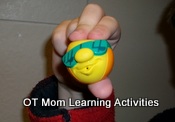 Squirt toys can strengthen fingers
Squirt toys can strengthen fingersPlaydough Fine Motor Activities
Playdough is one of my favorite fine motor resources for kids of all ages, and I have a whole page about this on my site.
Pop on over and see how to use playdough as a hand strength exercise as well as getting fingers moving for dexterity skills!
Age-Appropriate Fine Motor Activities
Throughout my fine motor pages and in my e-books, I deliberately don’t put an age to my activity suggestions, because I believe that most activities can be made simpler or more complex according to the age and ability of your child – some kids are more advanced than others.
The important thing is to start where your child is at, using the resources that you have available at home.
- For example if you think beading would interest your child, a very young/less capable child would start by threading large pony beads onto pipe cleaners/chenille sticks, or using large toddler beads like these#Ad
on shoelaces.
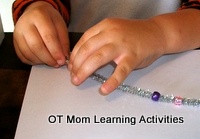
- Slightly more challenging beadwork would use pony beads on a thick elastic or nylon cord, while a teenager or a more accomplished child would be challenged by using small beads on a thinner cord#Ad.
Having said that, I do have some pages and suggestions geared to these two specific age groups on my site:
- Toddler Fine Motor Activities: If you have a toddler, then pop on over to see how to help your toddler develop fine motor skills with the resources you have on hand at home – you don’t need expensive toys or resources!
- Fine Motor Activities for Older Students: One of my more popular pages, you can try these fine motor activities for middle school students or for teenagers.
My book of fine motor activities has activities graded from basic hand strengthening exercises to more advanced pencil control activities.These can be used with most kids between the ages of 5 and 10 years. All these activities are photographed so you can see exactly what to do with your child!
My scissor cutting resources help kids move from learning to control the scissors in snipping activities, to cutting out more complex shapes. I use a variety of fun paper crafts to achieve this.
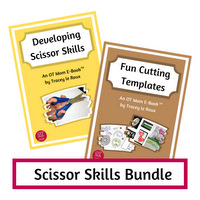
Thanks for visiting my site!
If you found this page helpful, you will probably enjoy the activities on these pages:
Why not check out some of the fine motor questions parents have asked over the years?
- Home Page
- About Fine Motor Skills
Share this page to help others!
References
Cornhill, H; Case-Smith, J. Factors That Relate to Good and Poor Handwriting. 50(9):732-9 · November 1996 http://dx.doi.org/10.5014/ajot.50.9.732
Ohl, A. M., Graze, H., Weber, K., Kenny, S., Salvatore, C., & Wagreich, S. Effectiveness of a 10-week Tier-1 Response to Intervention program in improving fine motor and visual–motor skills in general education kindergarten students. American Journal of Occupational Therapy, 67, 507–514. Sep/Oct 2013 http://dx.doi.org/10.5014/ajot.2013.008110
Weintraub, N. ;Graham, S. The contribution of gender, orthographic, finger function, and visual-motor processes to the prediction of handwriting status. The Occupational Therapy Journal of Research; 20(2):121-140 · March 2000 http://dx.doi.org/10.1177/153944920002000203
Fine motor goals and teaching practices for teachers https://headstart.gov/school-readiness/effective-practice-guides/fine-motor-know (last checked 2025-02-27)
Didn't find what you were looking for? Try a search of my site!
